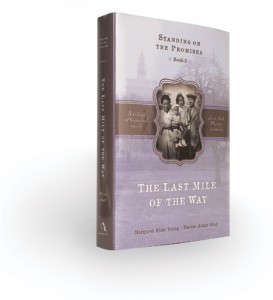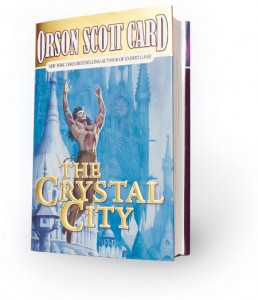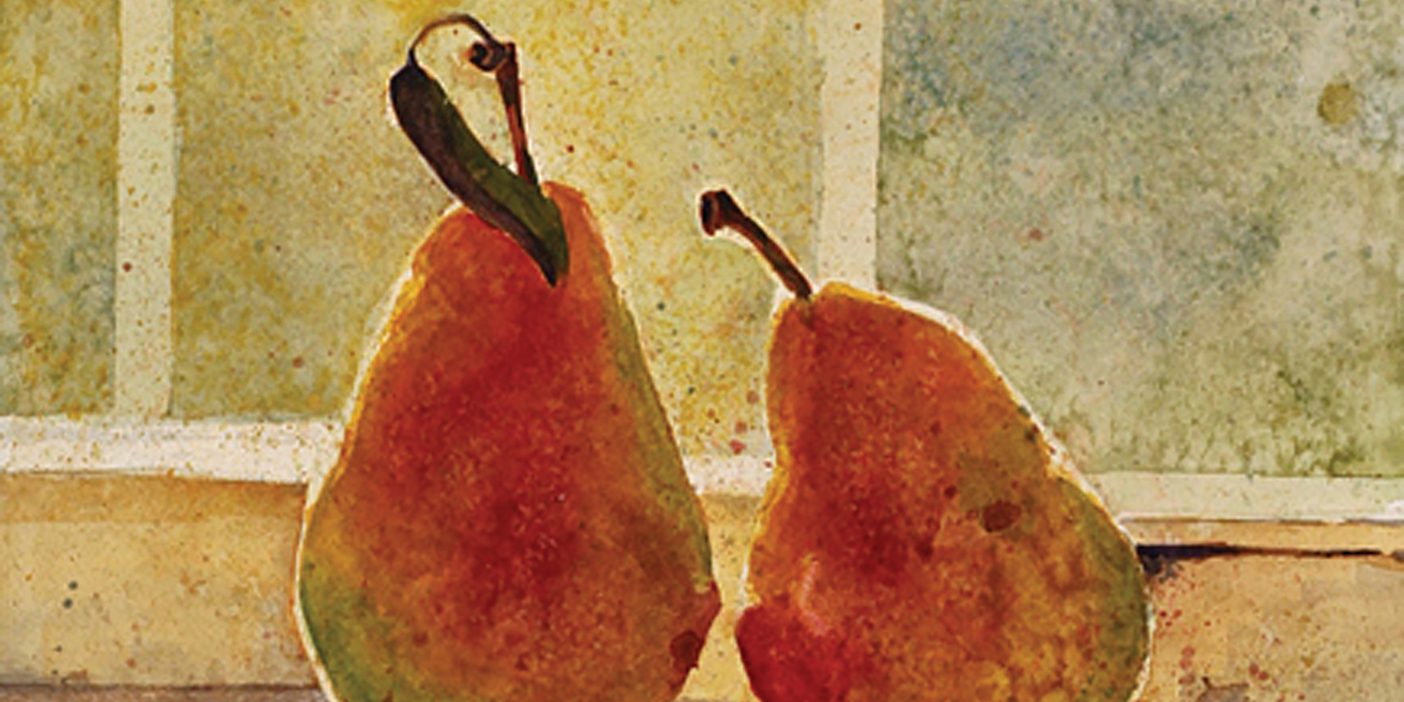By Richard H. Cracroft, ’63
 Two new novels celebrate racial equality and freedom.
Two new novels celebrate racial equality and freedom.
IN their landmark historical novel, The Last Mile of the Way (Bookcraft; 448 pp.; $21.95), Margaret Blair Young, ’79, and Darius Aidan Gray have brought to a satisfying, if bittersweet, conclusion the story of black Latter-day Saints’ struggle over nearly a century and a half to stay “true to the faith” despite being unable to hold the priesthood and receive temple blessings. Published, fittingly, during the 25th anniversary of the 1978 revelation, The Last Mile of the Way is the final volume in the Standing on the Promises trilogy—the Mormon version of Harriet Beecher Stowe’s Uncle Tom’s Cabin (1852). The series is a soul-opener that should be read by every Latter-day Saint.
In novel form The Last Mile of the Way recounts the last years of real-life black pioneers Elijah Abel, Jane Manning James, and Green Flake and follows their literal and spiritual descendants. Young and Gray trace the struggle from the end of the 19th century through the present by recounting—with wonderfully riveting chapter endnotes—the struggles of such resilient and tenacious black Latter-day Saints as Abner and Martha Howell, Len and Mary Hope, Lucille Bankhead (a great-granddaughter of Green Flake), Monroe Fleming, Eugene Orr, Ruffin Bridgeforth, and Darius Aidan Gray (one of the authors). Sadly, the hoped-for blessings of the 1978 revelation would come too late for these stalwarts’ children, most all of whom rejected the Church of Jesus Christ because of not being able to receive the priesthood.
Young, a descendant of white Mormon pioneers, a novelist, and a creative-writing teacher at BYU, and Gray, a grandson of a slave born in Missouri, a former KSL television journalist, and the president of the Church’s official black support group (Genesis), have done a remarkable job of setting the history of racial prejudice in Utah in the broader historical context of black history in the United States.
Young and Gray also introduce some happier stories of encouragement and love from Church leaders, including two white General Authorities who are especially revered by black Mormons: Elder Marion D. Hanks, whose quiet but substantial support of black Saints, dating from his mission in the late 1930s, is legendary, and President Spencer W. Kimball, by whom came the welcome revelation proclaiming that “all worthy male members of the Church may be ordained to the priesthood without regard for race or color” (OD 2).
These three engrossing volumes culminate in 2002 with Gray’s symbolic return to Nauvoo and the newly restored temple, which he entered vicariously in the stead of the 19th-century black Saints who did not live to see the promised day but nonetheless contributed to the building of the Nauvoo Temple and later temples. This series brings a sweet and powerful sense of completion and beginning, grounded as it is in deep faith in the Restoration and in a loving and even-handed God who, praise be, moves in mysterious ways to accomplish his ultimate purpose: setting all his children free.  Orson Scott Card, ’75, in a very different and typically imaginative fictional approach to battling for racial equality and freedom, has the Maker Alvin Miller Jr. (a fictional counterpart to Joseph Smith Jr.) enlist young attorney Abraham Lincoln and Tenskwa-Tawa, the Red Prophet, to assist him in freeing black slaves and other downtrodden poor of Nueva Barcelona. In The Crystal City(Tor; 384 pp.; $25.95), Card presents, at long last, the sixth (and probably final) volume in his fantasy series, The Tales of Alvin Maker. In this parallel twist on American history, the prolific Card has Alvin, assisted by the likes of Lincoln and the Red Prophet, lead 6,000 freed black slaves Moses-like to the Crystal City, west of the Mizzippy, where the emancipated slaves are born again under the leadership of Alvin, his brother Measure, and Verily Cooper to build the temple-like crystal tabernacle shown to Alvin in vision many years before. But visions of Alvin’s and Measure’s deaths foretold, at the hands of proslavery forces, cloud the promising future.
Orson Scott Card, ’75, in a very different and typically imaginative fictional approach to battling for racial equality and freedom, has the Maker Alvin Miller Jr. (a fictional counterpart to Joseph Smith Jr.) enlist young attorney Abraham Lincoln and Tenskwa-Tawa, the Red Prophet, to assist him in freeing black slaves and other downtrodden poor of Nueva Barcelona. In The Crystal City(Tor; 384 pp.; $25.95), Card presents, at long last, the sixth (and probably final) volume in his fantasy series, The Tales of Alvin Maker. In this parallel twist on American history, the prolific Card has Alvin, assisted by the likes of Lincoln and the Red Prophet, lead 6,000 freed black slaves Moses-like to the Crystal City, west of the Mizzippy, where the emancipated slaves are born again under the leadership of Alvin, his brother Measure, and Verily Cooper to build the temple-like crystal tabernacle shown to Alvin in vision many years before. But visions of Alvin’s and Measure’s deaths foretold, at the hands of proslavery forces, cloud the promising future.
Latter-day Saints will enjoy Card’s remarkable power in this landmark series in Mormon literature, with its many parallels to the life and mission of Joseph Smith, the founding of Nauvoo, and its suggestions of the westward trek and the children of Israel’s wanderings in the desert. While others won’t have a clue about these enriching parallels, they will nonetheless sense their mythic presence. Central to the tale is the continuing story of half-black Arthur Stuart, whose mother died bringing Arthur out of slavery and who is now being trained as a Maker. The Tales of Alvin Maker comprises six volumes: Seventh Son, Red Prophet, Prentice Alvin, Alvin Journeyman, Heartfire, and The Crystal City. The series is a landmark in Mormon literature; these are among the few essentially Mormon novels read by a large non-Mormon readership.
Book of Mormon Studies for 2004
I think the most important books about the Book of Mormon are Hugh Nibley’s Lehi in the Desert (Deseret Book, 1952); Book of Mormon Reference Companion (Deseret Book, 2003), edited by Dennis L. Largey; and By the Hand of Mormon (Oxford, 2002), by Terryl L. Givens, ’81. Here are a number of new books that will also enhance your study of the Book of Mormon.
The Book of Mormon: A Reader’s Edition (University of Illinois; 697 pp.; $39.95), edited by Grant R. Hardy, ’84, is a reader-friendly edition of the Book of Mormon (1920 text). Much like modern translations of the Bible, the text is reformatted with paragraphs, topical headings, quotation marks, and other helps to facilitate reading ease—including a hypothetical map based on internal references. Hardy’s introduction is faithful, clear, and useful. This edition, the first return to a paragraph format since 1879, makes the book especially helpful and intelligible to new readers and provides refreshing insights to Latter-day Saints. It’s also a good way to introduce the Book of Mormon to friends.
Matthew B. Brown, ’98, in Plates of Gold: The Book of Mormon Comes Forth (Covenant; 217 pp.; $18.95), presents a number of little-known historical facts with familiar accounts to give an authoritative and complete description of the coming forth of the Book of Mormon.
Joseph L. Allen ’80, in Sacred Sites: Searching for Book of Mormon Lands (Covenant; 107 pp.; $29.95), combines in fascinating text and beautiful photography, sufficient amounts of archaeology, history, geography, and scripture to support his thesis that “Mesoamerica is the logical geographic region in the Americas that meets existing time and place requirements mentioned in the Jaredite and Nephite records” (book flap).
By the Hand of Mormon: Scenes from the Land of Promise—Fine Art by Walter Rane (Deseret Book; 69 pp.; $24.95) captures 16 classic, dramatic moments from the Book of Mormon in 17 striking paintings. These wonderful portrayals of Nephi’s bondage, Enos’ prayer, the baptism at the Waters of Mormon, the smiting of Alma the Younger, Moroni’s lament, and scenes from the New World ministry of Christ seem destined to become enduring classics in Book of Mormon art.
Two recent novels suggest the increasing use of the Book of Mormon in fiction that seeks at once to instruct and delight. In volume 3 of the The Promised Land series, Place of Refuge (Covenant; 512 pp.; $23.95), David G. Woolley, ’85, continues his richly imaginative rendering, authentically grounded in anthropological, geographical, and cultural detail, of the Old World travels of Father Lehi and his family, en route to the promised land. Douglas V. Nufer, ’87, in The Title of Liberty (Granite/Peepsock; 403 pp.; $22.95), recounts imaginatively the heroic saga of the Nephite-Lamanite wars of 76–74 b.c. Nufer offers an exciting tale of the military exploits and strategies of Captain Moroni, who leaves his family and farm to rally his countrymen around the title of liberty. Nufer carefully grounds this adventure in the Nephite chronicles, and his chapter notes point out the differences between history and imagination.
Richard Cracroft is Nan Osmond Grass Professor of English, emeritus.
MORE CRACOFT PICKS: THREE RECENT MORMON NOVELS
By Richard H. Cracroft, ’63
The Conversion of Jeff Williams (Signature; 160 pp.; $18.95) by Douglas H. Thayer, ’55, is a coming-of-age novel, set on Provo’s east bench, and is one of the best, truly Mormon novels to bless our literature in a long time. Buy it, read it, and return to this column in the next issue, when I will tell you why I think Thayer’s latest novel is “a tender and moving love song to spirituality and a Mormon world view” (back cover).
Marilyn Arnold, ’57, is untiringly prolific in her retirement from the BYU English Department. After her stunning commentary on the Book of Mormon, Sweet Is the Word, her Desert Song trilogy, and Fields of Clover, Arnold does it again in The Classmates: A Mystery Novel (Bonneville/Cedar Fort; 292 pp.; $15.95). This time she ventures wittily, lightly, and murderously into a mystery about multiple murders of aging high school classmates in Yucca Flats, Nev.
Miah’s Conversion (Best Books & Music; 369 pp.; $16.95), by Max G. Walters, ’78, is the beautiful story of Miah, a young widowed mother in ancient Babylon, and her son Caleb, who eventually falls in love with a Hebrew girl. It recounts her transformation from being full of hatred and desire for revenge to discovering the joy and power of redeeming love.—Richard H. Cracroft, ’63









